
Exhibition ponders 'Why so many Jews?'
Jerusalem exhibition tries to answer poignant question about Avant-Garde artists from Romania
Originally shown in June-October 2011 at the Jewish Historical Museum in Amsterdam, under the name “From Dada to Surrealism - Jewish Avant-Garde Artists from Romania, 1910-1938,” the exhibition consists of approximately 90 works of art, the majority coming from the Romanian National Art Museum, but also from Centre Pompidou, the Musée d’art moderne de la Ville de Paris, Israel Museum, museums from Tulcea and Galaţi (Romania), as well as from private collections in Bucharest, Tel-Aviv, Paris, Antwerp, New York and Philadelphia.
Arthur Segal (1875-1944), Marcel Janco (1895-1984), Tristan Tzara (1895-1962), M.H. Maxy (1895-1971), Victor Brauner (1903-1966), Jules Perahim (1914-2008) and Paul Păun (1915-1994) were artists who took part, at different stages, in what the Romanian media call “the Romanian avant-garde.” Radu Stern, a Lausanne-based art historian (also a Jew born in Romania), contests this very definition of the avant-garde movement, its so-called national character, arguing that it is not sustained by the historic context and contradicts the very objectives and ideals of those who put Bucharest on the literary and artistic map of Europe, especially in the interwar period.
As curator of the exhibition in Amsterdam, along with Edward van Voolen, Radu Stern - who has been researching the avant-garde since the 1970s, when he was still living in Bucharest - puts in a new perspective the contribution of these artists; being exposed to persecutions in their native country, they have professed universal values, by adhering to radical modernism or even by being the promoters of new trends that demolished the European artistic traditions predominant at the beginning of the 20th Century.
Despite the racism
The exhibition in Jerusalem is not entirely identical to the one in Amsterdam (which was seen by over 45,000 visitors), some paintings from Israeli collections being added to the original line-up. Thus, for the first time, two of Marcel Janco’s creations from his Dada period are paired: Ball in Zürich (Israel Museum) and Ballroom (Tel Aviv Art Museum). Radu Stern and Adina Kamien-Kazhdan, curator at the Israel Museum, together have succeeded in harmonizing the historic message (the social-political context and the personal dramas) with the aesthetic requirements, the exhibits chosen being representative of not only the different artistic trends, but also the spiritual and philosophical evolution of the avant-garde artists.
The official opening of the exhibition at the Israel Museum took place on November 11, 2011. Actress Anat Pick-Voice recited Dada poems from Cabaret Voltaire. The directors of the two museums, James Snyder from Jerusalem and Joel Cahen from Amsterdam, as well as Romanian Ambassador to Israel Edward Iosiper and Adina Kamien-Kazhdan spoke to a crowded room.
To the title of the exhibition in Israel’s capital was added the Hebrew word “Davka,” which is difficult to translate, its meaning being close to “Despite.” The message is clear: despite the racial laws, despite anti-Semitism, despite Romanian nationalism, these Jewish artists succeeded in affirming themselves, promoting humanist, universal, pacifist, secular values of love for other human beings.
Under these circumstances, can we talk of a "Romanian avant-garde?" Almost all of the celebrated avant-garde artists from Romania were Jewish, victims of racial hatred, persecuted in their native country, guilty of being “allogenous,” “Kikes,” while the Romanian art of the time was obsessed by its search for "national specificity," excluding these "foreigners."
Therefore, this was not a “Romanian” avant-garde; it is absurd to label it thus, only because the artists were born in Romania. Can we, alternatively, state that the avant-garde in Romania was Jewish? No, because the values, the themes, the agenda of the avant-garde movement were stepping away from such distinctions (national or ethnic) and were not focused on Jewish topics or on the Mosaic religion.
Through the exhibition “Jewish Avant-garde Artists from Romania” and the research presented in its catalogue, Radu Stern provides a clear answer to the question “Why so many Jews?” The enigma can only be clarified by the historic conditions in the anti-Semite Romania in the interwar period, especially in the second half of the 1930s, and by solving the unknown of yet another question: “Why so few Romanians?”
Vlad Solomon, DMD, is an Israeli writer and publicist in the Romanian language, published in Israel and abroad










